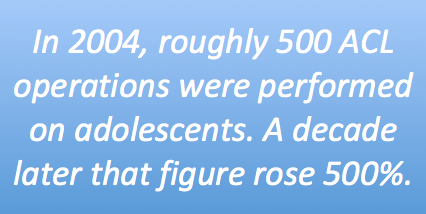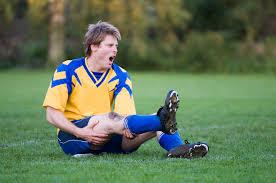Arthritis is not only for old folks.
If you badly injure your knee – regardless of age – you stand a significant chance of being afflicted with the condition, too. In fact, the chances of developing arthritis within 10 years of tearing a tendon or a ligament are more than 50 percent.
This is according to a soon-to-be-released paper written by an orthopedics professor at Harvard Medical School, who tracked the extreme rise of anterior cruciate ligament, or ACL, operations at dozens of children's hospitals over a recent 10-year period.
In follow-ups with patients the presence of arthritis was significant, with the age of the patient appearing to be irrelevant.
 “It’s like a dirty little secret,” said Dr. Mininder Kocher, who also works at Boston Children’s Hospital, as the Associate Director of its Sports Medicine Division. “It’s not that anyone is covering up. It’s just that it’s not well known,” added Dr. Kocher, in speaking to the New York Times.
“It’s like a dirty little secret,” said Dr. Mininder Kocher, who also works at Boston Children’s Hospital, as the Associate Director of its Sports Medicine Division. “It’s not that anyone is covering up. It’s just that it’s not well known,” added Dr. Kocher, in speaking to the New York Times.
Among his research, Dr. Kocher found that roughly 500 ACL operations were performed on adolescents at 26 hospitals in 2004. A decade later, in 2014, that figure rose 500%, to more than 2,500 surgeries. Torn ligaments, which can result from extreme twisting of the knee joint, are common soccer injuries.
And the sport has experienced explosive growth among teenagers in the U.S. during that time. For example, US Youth Soccer, saying it is the "largest member of the United States Soccer Federation, the governing body for soccer in the United States," itself has 3 million registered players (while in 1974, it had roughly 100,000.)
Meanwhile, these ACL operations are not limited to injuries resulting just from soccer. Any sport where knees are prone while twisting – basketball, lacrosse, tennis, skiing, for instance – can instigate the injury. But soccer has seen more than its share of injuries, and it's also a sport that has young participants with developing joints playing nearly year-round, which has been determined to greatly increase the chance of injury.
"Adolescent and teen girls face similar problems from overuse injuries. Doctors note that year-round soccer is particularly dangerous to developing knees," as we previously reported last June. "Tears in the anterior cruciate ligament, or ACL, are twice as common in girls as in boys. And playing a single sport over an extended period of time -- especially one which involves cutting and pivoting like soccer and lacrosse -- stresses their still-developing muscle and joint groups over and over again. And without strength training, which is often overlooked, surgeries are inevitable."
In addition, other joints are vulnerable as well, as the Times' story, published yesterday, pointed out. Ankles and shoulders can develop arthritis, and a previous study found that nearly 40 percent of patients with a dislocated shoulder developed the condition within 15 years.
So what can be done to reduce knee injuries?
A leading organization in the field comprised of orthopedic surgeons, called Sports Trauma and Overuse Prevention, or STOP, lays out some precautions. Stating that "[c]artilage tears and anterior cruciate ligament (ACL) sprains in the knee are some of the more common injuries that may require surgery," it recommends 11 ways to help steer clear of injury, ranging from using the right equipment, to proper hydration, to pro-active conditioning. This is a list certainly worth consulting.
Dr. Kocher has a personal connection to this field of study. He was a high school and college athlete who underwent a couple of knee surgeries, and he cites those experiences as why he entered the medical profession.




